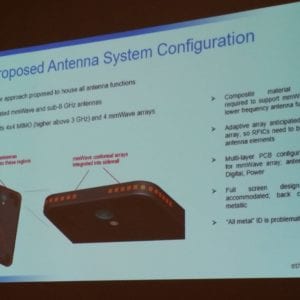The advent of 5G will mean significant changes for smartphone antenna design and location within devices, according to Jeff Shamblin, chief scientist for antenna company Ethertronics.
During remarks at the 5G Innovation Summit, Shamblin noted that most current smartphones are configured so that the five antennas commonly found inside — a main and secondary LTE antenna, Global Positioning System antenna, and 2×2 Wi-Fi — are grouped at the top and bottom of the device. He discussed the potential to take a four-sector approach for antennas, with co-located mmwave and sub-6 GHz antennas, that would still allow a full-screen design with a non-metallic back cover while supporting 4×4 multiple-input-multiple-output and four mmwave arrays basically wrapped around the device’s corners, integrated in the sidewalls.

Such a design would provide good mmwave coverage around the perimeter of the device, according to Shamblin. However, he noted, the front and back of the device still present challenges to omni-directional mmwave transmission and reception, and the arrays would need to be multi-layer.
In general, the mmwave spectrum propagation characteristics mean that a single mmwave antenna is essentially useless, Shamblin said — arrays are a must, in order to support beamforming to boost the mmwave transmission.
“The main difference we’re going to see as we move into 5G millimeter wave systems is, we’re now going to have a gain-formed beam that’ll have to be steered. So there’s going to be a very tight link between the millimeter-wave antenna and the baseband chipset as we do beam selection to optimize for the link,” Shamblin told RCR Wireless News. “But sub-6 GHz, we expect the antenna count to keep going up so we can support higher orders of MIMIO. The benefit is, when we do that, you’ll now be able to step into some fo the sub-6 GHz LTE bands and do some digital beamforming.”
Shamblin said that the industry is moving quite a bit faster than expected, particularly when it comes to the smartphone form factor.
“Actually, the past year we’re really had to kind of accelerate our development timeline, because we’re seeing the industry really want to bring mmwave technology, for example, into 5G smartphones sooner than we’d anticipated,” Shamblin said. “So we’ve ramped up our simulation and prototyping capabilities and we’re looking at chipset partners so we can actually design those adaptive or hybrid arrays and be ready for that first application.”
Watch the interview with Shamblin below:
Image copyright: nicholashan / 123RF Stock Photo

